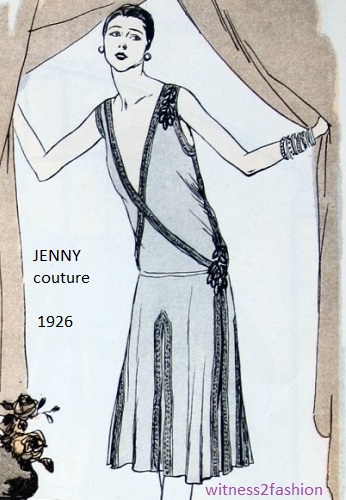
Evening dress by Jenny (Jeanne Adele Bernard Sacerdote) as sketched for Delineator, January 1926.
Some leading designers of the nineteen twenties have names that still sell fashion. Chanel comes to mind. Others were famous before and after the Twenties, like the House of Worth. Having a successful perfume brand helps: “Joy,” by Patou is still available. This is the first in a series about once-famous 1920s designers who are no longer well known.
Jenny (born Jeanne Adele Bernard, later Jenny Sacerdote) was ranked with those big names in the Twenties, but is not as well known today. I’ll be sharing a few of her designs, with links to help you find others.
These are merely a few of the designs by Jenny that were sketched for Delineator, *** and I do not have photos from every year between 1917 and 1930. Her ability to adjust to changes in fashion is admirable. Born in 1868, she became famous in her fifties, showing 300 pieces in her collection of 1918.
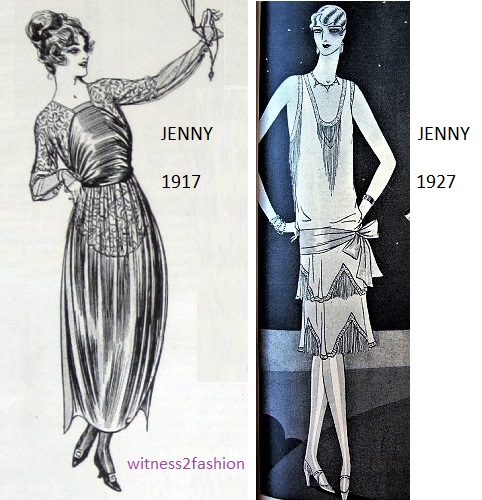
Two sketches of couture by Jenny (Jenny Adele Bernard Sacerdote ) shows her ability to move with the times. Delineator, 1917 and 1927.
Left, a gown with a “tonneau” or “barrel” skirt — a fashion innovation from 1917. Right, a bare, narrow, fringed and beaded evening gown from 1927.
Jenny in 1917
Jenny was already being copied in 1915. The V&A collection has several color sketches of Jenny designs. London dressmaker Elizabeth Handley Seymour sketched hundreds of French couture gowns and coats which she was prepared to duplicate for her customers. She included this coat by Jenny, this evening gown, and this elegant afternoon or evening gown.
Jenny was such a “star” in 1917 that even her underwear collections were featured in “Reports from Paris.” She’s notable for her use of bright colors and print fabrics (!) in her lingerie:
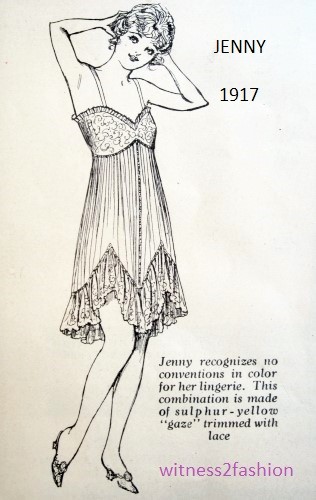
This frothy undergarment was “sulphur-yellow ‘gaze’ trimmed with lace.” Delineator, August 1917.
On Jenny’s pink satin knickers, cream yellow lace is outlined with little roses or ‘cocardes’ [sic] of satin ribbon:
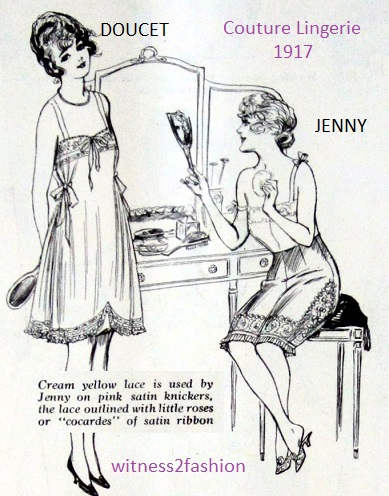
Doucet was a very well-established design house; Jenny is treated as his equal. Delineator, August 1917. Note the ribbon straps.
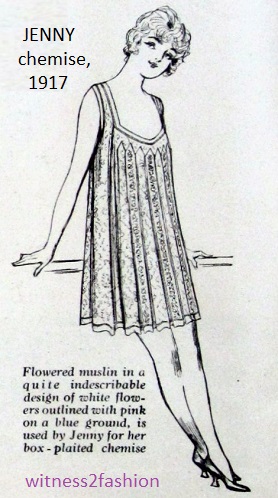
Print fabric lingerie by Jenny, 1917. Sketched for Delineator.
Jenny used “Flowered muslin in a quite indescribable design of white flowers outlined with pink on a blue background” for her pleated chemise, 1917. I remember how new and exciting print underwear was in the 1960s!
This pink chiffon Jenny dressing gown would have been called a “combing jacket” in an earlier era. (See “Peignoir.”)
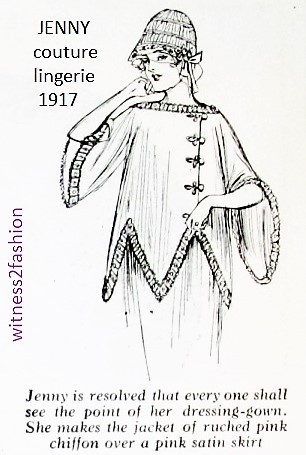
A dressing gown by Jenny in Delineator, July 1917: “ruched pink chiffon over a pink satin skirt.”
Other Jenny designs from 1917 show that she had a sense of humor. She named this dress, amply trimmed with fur, “My hairy one.”
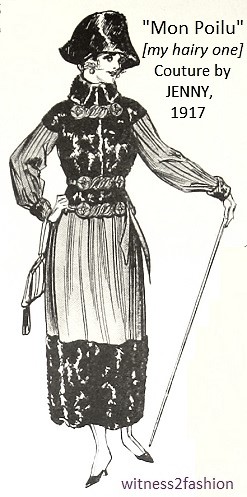
Jenny called this model “Mon Poilu” –“my hairy one.” Sketched for Delineator, December 1917.
However, her velvet skating dress seems a little impractical:

Jenny described this as a skating dress. Delineator sketch, December 1917. The tassels would be flying!
The coat below is actually sleeveless, worn over a matching gray silk dress. The geometric trim is stitching in green thread.
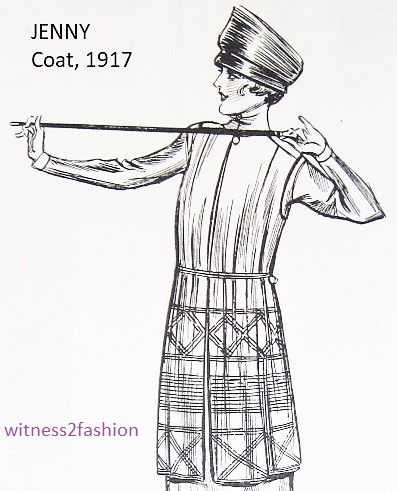
Short sleeveless coat over matching gray silk dress, green stitching. Jenny, sketched for Delineator, September 1917.
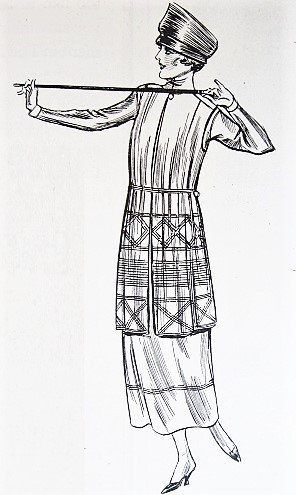


In June, 1917, Delineator showed a page full of couture designs which featured the new “barrel” silhouette. This was one from Jenny. Page 56.
Delineator claimed the barrel silhouette was chiefly the influence of Jeanne Paquin:
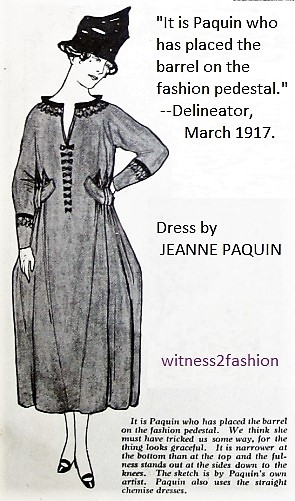
The barrel or tonneau skirt, sketched by Paquin’s own artist. Delineator, March 1917, p 56.
They look better to me when the model is sitting down.
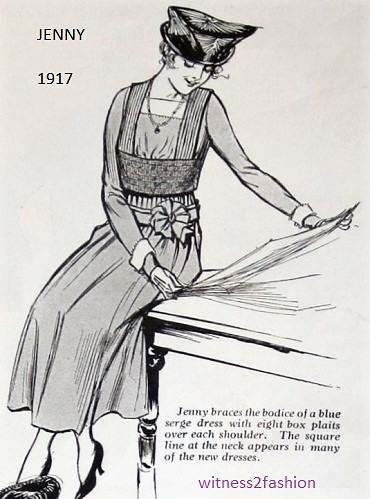
Jenny created this dress for 1917. Delineator, March, p. 56. “Blue serge dress with eight box plaits over each shoulder. The square line at the neck appears in many of the new dresses.”
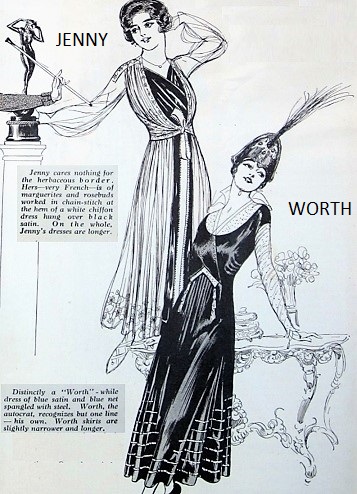
Left, a design by Jenny — in black satin under white chiffon embroidered with flowers — appears next to a design from the House of Worth. Delineator, March 1917.
I’m sure you could find many more Jenny designs: try searching for Delineator at Hathi Trust; select Journal, then choose a year, and search within the volumes you find. 1922 for example…
*** Note: Butterick Publishing Company had offices in Paris, giving their pattern makers a chance to follow the very latest trends, which were reported on several times a year, often illustrated by Soulie. All the illustrations I’ll use in this “Less Familiar Designers” series come from Delineator‘s coverage. Caveat: Pattern companies could sometimes buy couture items and copy them, but designers were not happy to be copied without any payment, so sketch artists attending fashion shows had to be quick and furtive, and sometimes had to work from memory. Read Fashion is Spinach, by Elizabeth Hawes for a sketcher’s real inside story.
Next: Jenny in the 1920s.
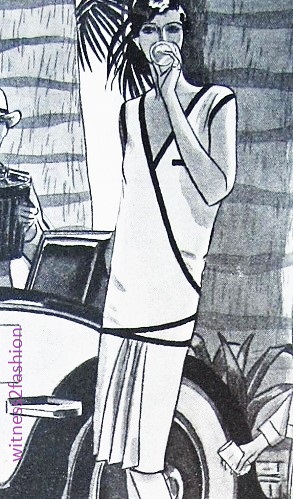
Tennis dress by Jenny, sketched for Delineator by Leslie Saalburg, February 1927.
